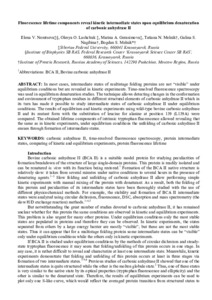Fluorescence lifetime components reveal kinetic intermediate states upon equilibrium denaturation of carbonic anhydrase II
Скачать файл:
URI (для ссылок/цитирований):
http://iopscience.iop.org/article/10.1088/2050-6120/aa994a/metahttps://elib.sfu-kras.ru/handle/2311/111492
Автор:
Немцева, Е. В.
Лащук, Олеся
Герасимова, Марина
Мельник, Татьяна
Нагибина, Г. С.
Мельник, Богдан С.
Коллективный автор:
Институт фундаментальной биологии и биотехнологии
Институт инженерной физики и радиоэлектроники
Кафедра биофизики
Кафедра общей физики
Дата:
2018-01Журнал:
Methods and Applications in FluorescenceКвартиль журнала в Scopus:
Q1Квартиль журнала в Web of Science:
Q2Библиографическое описание:
Немцева, Е. В. Fluorescence lifetime components reveal kinetic intermediate states upon equilibrium denaturation of carbonic anhydrase II [Текст] / Е. В. Немцева, Олеся Лащук, Марина Герасимова, Татьяна Мельник, Г. С. Нагибина, Богдан С. Мельник // Methods and Applications in Fluorescence. — 2018. — Т. 6 (№ 1). — С. 1-9Аннотация:
In most cases, intermediate states of multistage folding proteins are not ‘visible’ under equilibrium conditions but are revealed in kinetic experiments. Time-resolved fluorescence spectroscopy was used in equilibrium denaturation studies. The technique allows for detecting changes in the conformation and environment of tryptophan residues in different structural elements of carbonic anhydrase II which in its turn has made it possible to study the intermediate states of carbonic anhydrase II under
equilibrium conditions. The results of equilibrium and kinetic experiments using wild-type bovine carbonic anhydrase II and its mutant form with the substitution of leucine for alanine at position 139 (L139A) were compared. The obtained lifetime components of intrinsic tryptophan fluorescence allowed for revealing that, the same as in kinetic experiments, under equilibrium conditions the unfolding of carbonic anhydrase II ensues through formation of intermediate states.
Коллекции:
Метаданные:
Показать полную информациюСвязанные материалы
Показаны похожие ресурсы по названию, автору или тематике.
-
Variation of Spectral Characteristics of Coelenteramide-Containing Fluorescent Protein from Obelia Longissima Exposed to Dimethyl Sulfoxide
Petrova, A. S.; Alieva, R. R.; Belogurova, N. V.; Tirranen, L. S.; Kudryasheva, N. S. (2016)Effect of dimethyl sulfoxide (DMSO), a widespread biomedical agent, on spectral-luminescent characteristics of coelenteramide-containing fluorescent protein – discharged obelin – is investigated. Contributions of violet ... -
Ultravioletfluorescence of coelenteramide and coelenteramide-containingfluorescent proteins. Experimental and theoretical study
Alieva, R. R.; Tomilin, F. N.; Kuzubov, A. A.; Ovchinnikov, S. G.; Kudryasheva, N. S. (2016-09)Coelenteramide-containingfluorescent proteins are products of bioluminescent reactions of marine coelenter-ates. They re called‘discharged photoproteins’. Their light-inducedfluorescence spectra are variable, depending ... -
Ultraviolet fluorescence of coelenteramide and coelenteramide-containing fluorescent proteins. Experimental and theoretical study.
Alieva, R. R.; Tomilin, F. C.; Kuzubov, A. A.; Ovchinnikov, S. G.; Kudryasheva, N. S. (2016)Coelenteramide-containing fluorescent proteins are products of bioluminescent reactions of marine coelenterates. They are called ‘discharged photoproteins’. Their light-induced fluorescence spectra are variable, depending ... -
Ultraviolet fluorescence of coelenteramide and coelenteramide-containing fluorescent proteins. Experimental and theoretical study
Alieva, R. R.; Tomilin, F. N.; Kuzubov, A. A.; Ovchinnikov, S. G.; Kudryasheva, N. S. (2016)Coelenteramide-containing fluorescent proteins are products of bioluminescent reactions of marine coelenter- ates. They are called ‘discharged photoproteins’. Their light-induced fluorescence spectra are variable, ... -
Variability of fluorescence spectra of coelenteramide-containing proteins as a basis for toxicity monitoring
Alieva, Roza R.; Kudryasheva, Nadezhda S. (2017-08)Nowadays, physicochemical approach to understanding toxic effects remains underdeveloped. A proper development of such mode would be concerned with simplest bioassay systems. Coelenteramide-Containing Fluorescent Proteins ...

